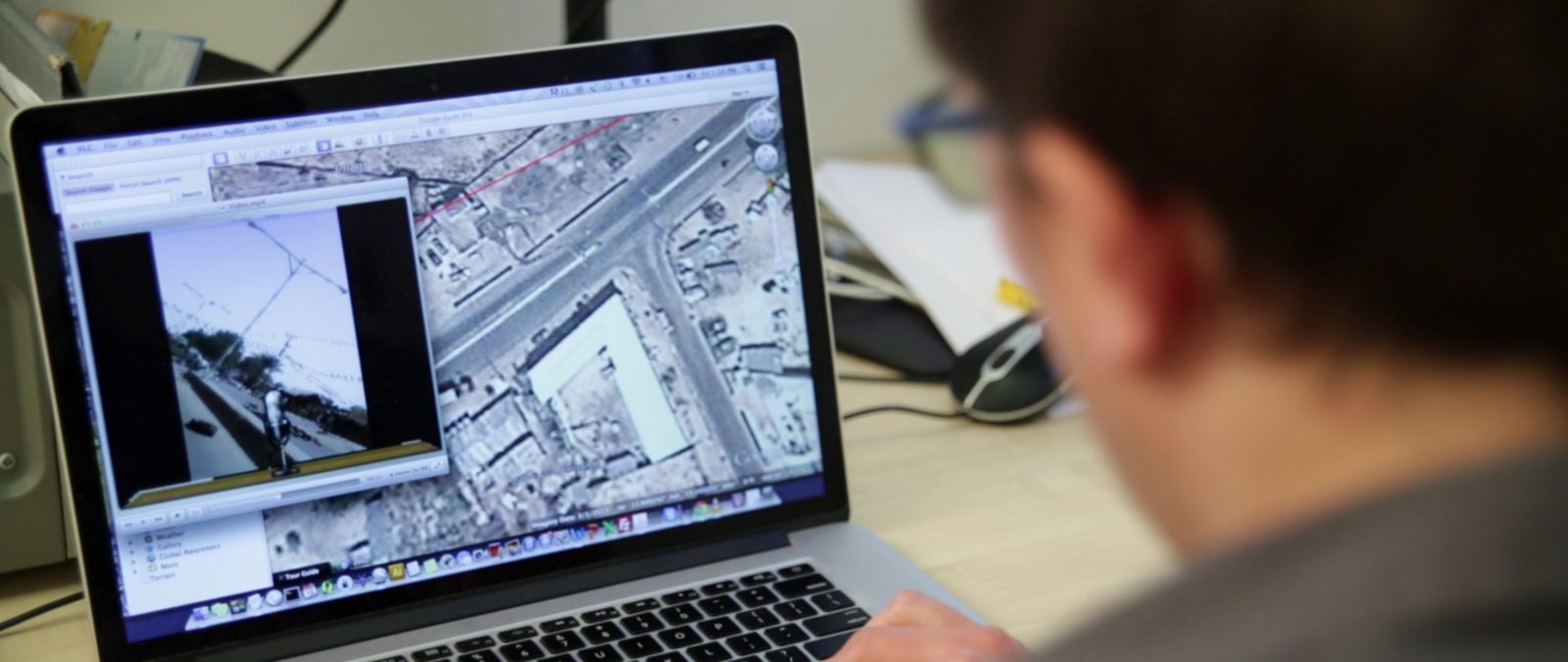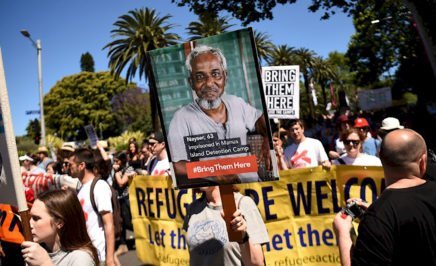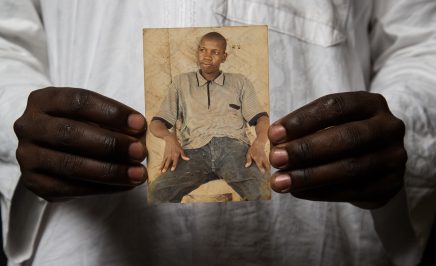By Conor Fortune, Senior Crisis Response Communications Adviser
Open-source investigators are collaborating online to verify and expose human rights abuses. Here’s how.
A grisly video showing a heinous act of violence quickly went viral after it was posted on 10 July 2018. Men dressed in army fatigues and wielding military-grade rifles brutally marched women and young children – including a baby strapped to his mother’s back – to a rural location before blindfolding and executing them in a hail of bullets.
As the video spread on social media, so did the rumours. Was this in Mali or Cameroon? Were they government armed forces or Boko Haram fighters masquerading as soldiers? Was it real or staged?
In situations like this, the “truth” can appear malleable, with those in power sometimes taking advantage of the confusion to peddle false narratives. That’s precisely what the government of Cameroon initially did. Fearing a backlash if the real story came out, on 12 July Cameroon’s Minister of Communication held a press conference where he attempted to dismiss the video as “fake news”.
But even if what is perceived as “truth” is malleable, the facts are not. The same day as the Minister’s press conference, Amnesty International’s forensic analysis of the video began to establish the facts of what happened. Our research followed meticulous open source investigation methodologies and the findings were corroborated by testimonies from the ground.
Relying on multiple strands of evidence – including geolocation of the video, expert analysis of the uniforms and weapons used, and linguistic and other contextual clues in the speech that gave away the identities and ranks of the soldiers – the organization was able to begin to build a case to counter the official narrative. The evidence strongly suggested that Cameroonian soldiers were the ones extrajudicially executing civilians in the video.
Subsequent research by Amnesty International bore this out, and a community of open source investigators collaborating on the case pin-pointed the exact location near the town of Zelevet and narrowed down the date to sometime in late March or early April 2015.
On 10 August, when another horrific video surfaced showing more military executions, the government of Cameroon backed down from its denials and announced that seven soldiers had been arrested and were under investigation for the Zelevet killings. A subsequent BBC Africa Eye documentary, Anatomy of a Killing – released on 24 September with support from Amnesty International and other open source investigators – detailed how those arrested included three soldiers who appear in the viral video.
“The Zelevet video fitted a wider pattern we had documented of the Cameroonian security forces committing egregious violations against civilians,” said Ilaria Allegrozzi, Amnesty International’s Lake Chad Researcher.
“Since we didn’t have direct access to the area around Zelevet to verify this in person immediately, our open source investigation allowed us to confidently nail down this incident as part of that same pattern, and call for those responsible to be investigated.”
Getting to the truth
Following massacres, bombings and other despicable acts of violence against civilians, those responsible often seek to evade justice. But the wealth of content now posted online by citizen journalists, activists or others means that more evidence is available to stop them in their tracks and mount a case against them.
“When inconvenient truths prompt public officials to cry ‘fake news’, or when content posted on social media purports to show something it doesn’t, we’re ready to respond, based on rigorous, methodical research and verification methods,” said Sam Dubberley, Manager of Amnesty International’s Digital Verification Corps.
“When powerful people control what people read, see and hear, it’s easy to manipulate the official story and maintain impunity for serious violations. But when footage of the facts on the ground pokes holes in that narrative, it can make a stronger case for prosecution and the delivery of justice.”
A key part of this work is Amnesty International’s Digital Verification Corps – a network of more than 100 volunteers at six global universities, who the organization has trained in verification skills.
Amnesty International has used verified videos and photographs to help prove the burning of Rohingya villages in Myanmar, tactics of unlawful sieges and bombardment of civilian populations in Syria, and governments endangering the lives of refugees in Papua New Guinea.
“We have to do this to help people tell their stories. But we go to great pains to carefully verify their information. When we are not on the ground to witness these events as they happen, the onus is on us to prove beyond a shadow of a doubt that they really did happen,” said Sam Dubberley.
Shooting on Manus Island
On 14 April 2017, a shooting occurred at the Manus Island Detention Centre in Papua New Guinea, where the Australian government detains more than 800 refugees and asylum seekers.
In the immediate aftermath, Manus Province police commissioner David Yapu tried to downplay media reports about the shots endangering the detainees’ lives. “The soldiers fired several gunshots in the air, causing great fear and threats to the local and international community serving at the centre,” he said.
Amnesty International carried out an open source investigation into 21 images and six videos captured by refugees near the scene of the 14 April shooting, and published a detailed report of its findings on 15 May.
Hours after the report came out, Commissioner Yapu changed his position. “Some of the shots were fired through the compound and some of the bullets penetrated through the walls”, he conceded the same day. An official inquiry was later launched into the incident.
Criminal investigations
Inevitably, some governments try to protect those among their ranks who are responsible for crimes under international law. In other cases, the national criminal justice system is too politicized, broken or flawed to bring perpetrators to justice in fair trials.
In these cases, where governments are unable or unwilling to bring suspected war criminals and other serious offenders to justice, the International Criminal Court can open an investigation – if it has jurisdiction. But even where the ICC has jurisdiction, it is rare for the Court to issue an arrest warrant on the basis, at least in part, of evidence found on social media networks like Facebook and YouTube.
That is why it was such a watershed moment for open source investigations when the ICC issued an arrest warrant for Mahmoud al-Werfelli in August 2017, for the war crime of murder in Libya. Videos shared on social media – which the Court thoroughly analysed and verified using the same stringent methodology that Amnesty International employs – were a significant factor in the decision to order his arrest.
“The al-Werfelli case shows how crucial digital verification has become in forging a path to justice for the world’s worst crimes,” said Sam Dubberley.
“Open source investigators have done ground-breaking work to cut through the noise and expose the facts behind other grave abuses including Bellingcat’s exposé on the downing of flight MH17 over eastern Ukraine, or the New York Times’ work on the use of chemical weapons by Syrian forces in Douma and Khan Sheikhoun.”
Just as in journalism and criminal investigations, tackling misinformation and getting to the truth matters more than ever in the field of human rights research. Amnesty International has pioneered using open source investigations to bolster its traditional testimonial research to expose human rights violations, change the official narrative and pave the way for justice.
To find out more about Amnesty International’s work on open source investigations and digital verification, visit the Citizen Evidence Lab: https://citizenevidence.org/



